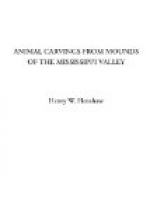The possibility of the manatee having in past times possessed a wider range than at present seems to have been overlooked. But as a matter of fact the probability that the manatee ever ranged, in comparatively modern times at least, as far north as Ohio without leaving other traces of its presence than a few sculptured representations at the hands of an ancient people is too small to be entertained.
Nor is the supposition that the Mound-Builders held contemporaneous possession of the country embraced in the range of the animals whose effigies are supposed to have been exhumed from their graves worthy of serious discussion. If true, it would involve the contemporaneous occupancy by the Mound-Builders, not only of the Southern United States but of the region stretching into Southern Mexico, and even, according to the ideas of some authors, into Central and South America, an area which, it is needless to say, no known facts will for a moment justify us in supposing a people of one blood to have occupied contemporaneously.
Assuming, therefore, that the sculptures in question are the work of the Mound-Builders and are not derived from distant parts through the agency of trade, of which there would appear to be little doubt, and, assuming that the sculptures represent the animals they have been supposed to represent—of which something remains to be said—the theory that the acquaintance of the Mound-Builders with these animals was made in a region far distant from the one to which they subsequently migrated would seem to be not unworthy of attention. It is necessary, however, before advancing theories to account for facts to first consider the facts themselves, and in this case to seek an answer to the question how far the identification of these carvings of supposed foreign animals is to be trusted. Before noticing in detail the carvings supposed by Squier and Davis to represent the manatee, it will be well to glance at the carvings of another animal figured by the same authors which, it is believed, has a close connection with them.




